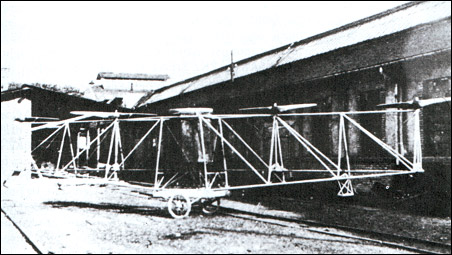
| Petroczy PKZ 1 1922 - project |  |
 |

| Petroczy PKZ 1 1922 - project |  |
 |
|
Oberleutnant Dr. Theodor von Karman (later of Cal Tech fame) and Ingenieurleutnant Wilhelm Zurovec, both attached to Flars, were assigned the task of constructing a prototype helicopter applying the latest information from the propeller laboratory. Eschewing endless theoretical calculations, Karman and Zurovec proceeded with empirical trials. As first envisaged, the tethered helicopter had 10 to 12 lifting rotors arranged in a circle, but the problem of weight and complexity reduced the final choice to a four-rotor design. After testing rubber-band powered models without success, Zurovec conceived a unique compressed air motor (weighing 4kg and developing 6hp at 2400 rpm) which enabled him to construct a 35kg flying model. Starting in Junc 1917, flight tests explored various stabilizing surfaces, center of gravity shift, and rotor configurations. Unable to achieve dynamic stability with one or two tethering cables, Karman and Zurovec found that a three-cable system gave the best results. A further 50 flights, ranging in height from 10 to 15 meters, were performed in the great balloon hangar at Fischamend between July 1917 and March 1918. Meanwhile, on 21 August 1917, the MAG company in Matyasfold had been given the task of building a full-scale, manned helicopter based on the Karman-Zurovec model work. Having little financial incentive and directed by the military bureaucracy, MAG progress was slow, to some degree due to late delivery of the Daimler electro-motor. Completion, scheduled for October, did not occur until February 1918. The aircraft, called a Schraubenfesselflieger (SFF - rotor-driven tethered aircraft) was identified in post-war literature as the Petroczy-Karman-Zurovec PKZ 1. The design was patented jointly by Karman and Zurovec (German patent 346,425, dated 28 June 1917). Karman remained as project director, but it appears that Zurovec began work on his own PKZ 2 helicopter project in November 1917. The PKZ 1 motor weighed 195kg and produced 190hp at 6000 rpm - 60hp less than projected because the winding insulation was of inferior quality. In flight, power would have been transferred by an aluminum cable 800 meters long. On the first test in Fischamend (date unknown), the PKZ 1 (empty weight 650kg) took off with surprising abruptness at a rotor speed of 700 rpm and rose to the maximum tethered height of 50cm. Next, three men climbed aboard and the helicopter easily hovered at the limit of the restraining cables. After 15 minutes into the fourth flight, the over-burdened motor burned through. With high-grade electrical copper and quality insulation impossible to obtain, Daimler was unable to repair the motor. Since the private initiative of Liptak had sped the PKZ 2 to completion, the PKZ 1 was transferred to the Liptak factory but, lacking a motor, nothing was done. Nevertheless, the PKZ 1 had demonstrated the feasibility of an electric-powered helicopter as predicted by the model tests in Fischamend. Peter Grosz "Austro-Hungarian Army Aircraft of World War I", 2002
Prior to the First World War, it seemed that no one quite knew what the helicopter was good for, much less how to solve the problems associated with it. A balloon could certainly accomplish the primary requirements for the helicopter: vertical take-off and landing, and hover. With the success of the airplane, it seemed to many that the rotary wing inventors were wasting their time with helicopters and had missed the news that powered flight had been achieved. Fixed wing aircraft quickly found military uses during World War I, however, first for reconnaissance, and then as bomber and fighter aircraft. The aircraft was also found to be quite adept at shooting down enemy reconnaissance balloons. The balloon, however, had a much needed capability that the airplane lacked: the ability to connect a telephone line to the ground to report the events from the battlefield. During the war, Lieutenant Stefan von Petroczy of the Austrian Army Balloon Corps initiated a project to develop a tethered, armed aerial observation platform that could be quickly reeled in when needed. Under the technical guidance of the now legendary Theodore von Karman, with assistance from Ensign Wilhelm Zurovec, a 650kg full-size machine, referred to as the PKZ 1, was begun in Budapest in October 1917. A 190hp Austro-Daimler electric motor was used to drive two propellers in front of the observer and two behind. The electrical power was transmitted through a cable but still the motor weighed 195kW. Four test flights were made in March 1918 up to a height of 6m, but the motor burned out, preventing further tests.
|